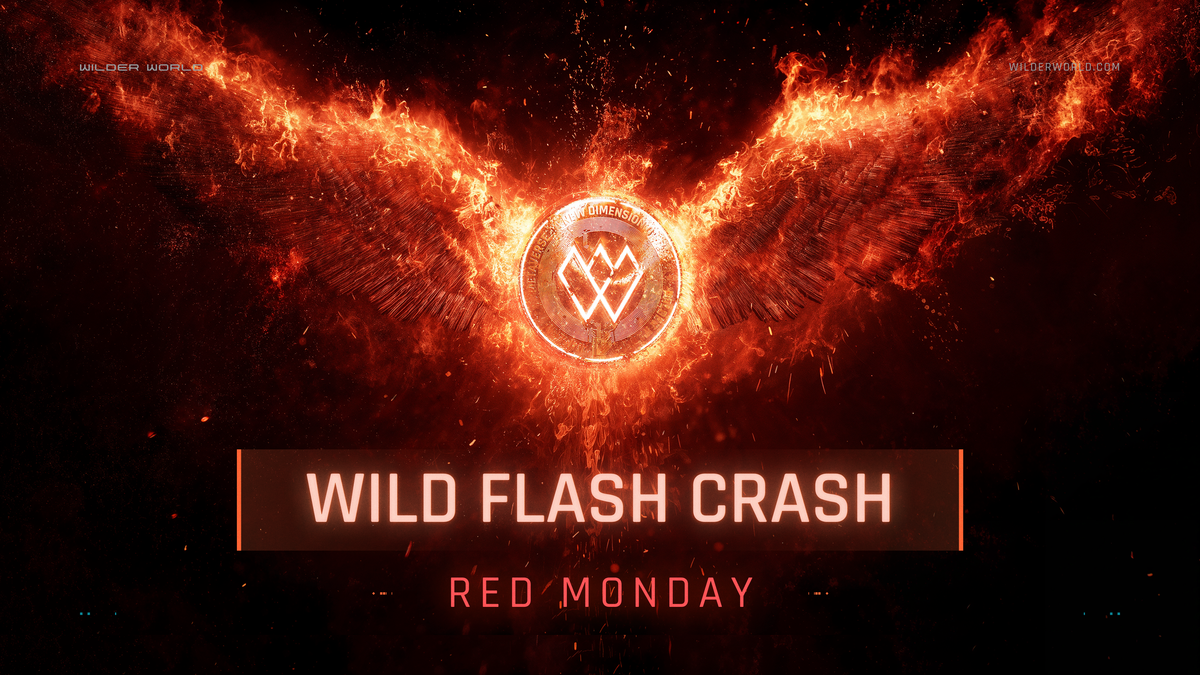Red Monday: WILD Flash Crash

Wilders:
I want to sincerely apologize to anyone directly impacted by the recent WILD price crash. In this ZINE we will give you a brief summary of what happened, how the situation intensified, and what happens next.
I want to make it clear that this crash will not impact our plans:
- We have 12 months+ of operating capital, nearly $10 million in hard asset reserves, ~50 million in WILD tokens across companies, and no debt.
- Since mid-September we have seen weekly active users grow by 97%; average daily Z Chain transactions have grown to ~40,000 per day.
- We are on track for our Open World release on December 16th this year.
This evening (Monday, November 3, 2025) we will host a public X Spaces to answer questions related to the WILD crash and Peapods deleveraging event. We welcome any and all hard questions so we can get past this, recover and focus on winning.
Tomorrow (Tuesday, November 4, 2025) we will host a public X Spaces focused on what to expect over the coming 45 days. This will no doubt be the most important and exciting period of Wilder World history.
What Happened?
On September 3, 2025 we announced a strategic partnership with Peapods and the integration of the WILD token into the Peapods protocol for Leveraged Volatility Farming (LVF).
The intention of this integration was to:
- Add borrowing utility for WILD token holders,
- Deepen ‘full-range’ liquidity to support the WILD token, and
- Generate yield for idle treasury tokens.
I take 100% responsibility for our part in this situation. Ultimately, this was a case of us not understanding the nuanced tail risks for how the protocol would behave under different adversarial conditions, and having too large of a position. We should have spent more time on the actual mechanics of how the system worked, before taking risk and recommending it to our community.
In addition to our own responsibility, I do think there are critical improvements that need to be made to the Peapods protocol. On October 10th, 2025, a similar situation happened to the official Peapods pod, where a cascading liquidation occurred, which resulted in a similar fate.
Core Mistakes:
The Peapods system enables users to stake their WILD in exchange for a full-range LP receipt token (similar to a Uniswap V2 AMM pool). All LP receipts in Peapods are automatically set to a minimum of 2x leverage, with WILD acting as collateral for the full range LP position. In addition, there is an option to move the leverage factor to 2.33 - 2.66x.
The advertised proposition of Peapods is to generate positive APY by Leveraged Volatility Farming (LVF), such that pod position debt is offset by positive ‘volatility farming’. As part of our core LP staking migration plan, the foundation initially staked ~20 million WILD from our treasury (~4% of the supply) to bootstrap the pod. Other whales and community members also added WILD, further increasing the pod size.
Large positions began being added to the pod on September 3, 2025. Subsequently, more positions were added to increase the pod size, as well as purchase additional WILD on market.
Core Learnings:
We had three core misunderstandings as it relates to the architecture of the Peapods protocol:
- Default Debt Liability: We were under the impression standard positions would stay balanced on a symmetrical basis similar to a regular AMM, irrespective of market direction. We did not realize that if the price went down we would incur significant USD denominated debt, with major interest for a standard position. As the WILD price decreased, we incurred a $3 million+ liability on our position. This wasn’t just for us–many Wilders and whales experienced the same thing–not fully understanding how debt was accumulated for standard LP provisions.
- Asymmetric Downside Protection: When opening a standard WILD LP position in the protocol, a synthetic version of USDC (pfUSDC-40) is minted, which is paired with a wrapped version of WILD (pLONGWILD). When opening a new LP position, a Balancer flash loan is also initiated to mint the required amount of pfUSDC-40. What we learned later however, is that this flash loan is immediately repaid in the same block, and that USDC liquidity is not 1:1 backed. Given that USD backing was only fractional and dynamic, there always existed a possibility for a ‘run on the pod’.
- Convertible Debt Receipts: When lenders provide USDC to fractionally back synthetic pfUSDC-40 (from Learning 2), they receive a receipt token that enables them to convert their token to actual USDC in the underlying pod. What we did not realize is a mechanism that allows pfUSDC-40 to convert and rapidly exit to pLONGWILD, which can be unwrapped and sold at a relative discount on the market, driving the main market price down.

The Cascading Liquidation:
After the WILD price crashed from $0.33 in mid-September to $0.20 in late October, the pod incurred significant interest expense and added debt (see Learning 1). Once we became aware of the extent of the issue, we worked with the Peapods team to devise a plan to protect the pod.
Given that other market participants also had debt and similar liquidations at risk, it was critical to protect not just our positions, but everyone else's positions, in order to prevent a cascading liquidation event.
Given this event (as well as Learning 2), on October 31st, 2025 we devised a plan to protect the pod by utilizing $3 million of the available $5.2 million in the lending pod. We left $2.2 million in the pod to attract lenders and ensure there was additional support for the pod and lenders.
The $3 million was then used to create a large buy wall at $0.20 to protect the pod. After 24 hours however, a large percentage of the buy wall was eaten through, and the pod began to de-peg upwards, further reducing the health for lenders. To close the peg, we began purchasing WILD on the market, while leaving a $500K buy wall at $0.20, with additional backup capital that could be used as necessary.
Soon after (when we became aware of Learning 3), a pod lender initiated a full position liquidation on the pod. At no point did we realize lenders could swap their lending receipt token for pLONGWILD, and dump WILD onto the market. They continued to eat through the remaining buy wall, where liquidations were hit.

Token Impact
We still need to confirm exact numbers, but this is roughly how the token was impacted:
- During the crash the token rapidly plummeted.
- All WILD staked in the pod sold between $0.20 and < $0.01.
- Roughly 50 million tokens were sold onto the market (10% of the supply).
We are still trying to understand the exact mechanism for the liquidation and at what prices tokens were sold. Despite this challenge however, the token has rebounded quickly and we believe it is possible to fully recover quickly.
Many Wilders have purchased tokens at generationally low prices, giving them a better price entry or lowering their existing cost basis.

Summary
I want to reiterate my sincere apologies to anyone impacted by this event. Please know that we are working around the clock to restore stability for WILD holders. Our team is also working around the clock and we believe we will blow everyone away in mid-December, when we unveil the open world everyone has been waiting for.
Please join or listen to the upcoming X Spaces AMA, where we will address the questions posted on X, and in the typeform, by all community members.
This has been an incredibly intense and stressful time, but the support and love from the Wilder World community has made me more committed and determined than ever to see our vision materialize.
n3o
